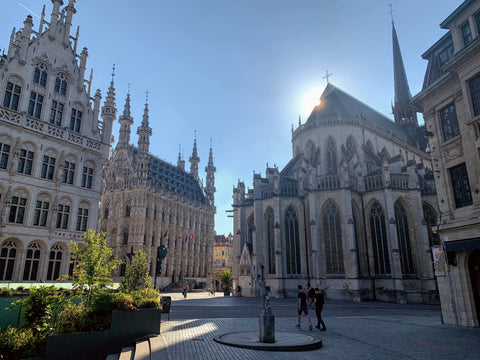A Historic Landmark in Leuven’s Grote Markt
Located in the heart of Leuven’s Grote Markt, Saint Peter’s Church (Sint-Pieterskerk) is a stunning Brabantine Gothic masterpiece that has stood the test of time. Originally built in the 15th century, the church is one of Leuven’s most significant historical and artistic landmarks, boasting an impressive collection of religious art.

A Church Rebuilt Through the Centuries
🏛️ From Wooden Beginnings to Gothic Grandeur
- The first church on this site was built in 986, but it was made of wood and burned down in 1176.
- It was replaced by a Romanesque church, which stood until the early 15th century.
- The current Gothic structure was begun in 1425, sharing architects with Leuven’s Town Hall, including:
- Sulpitius van Vorst
- Jan II Keldermans
- Matheus de Layens
Despite its ambitious design, the church towers were never fully completed. However, they are still recognized on the UNESCO World Heritage List as part of the Belfries of Belgium and France.
A Church Rich in Art & Heritage
🎨 Masterpieces Inside Saint Peter’s Church
The church has an exceptional art collection, including:
- 🖼️ The Last Supper by Dieric Bouts (1464-1468) – One of the most famous Flemish Primitive paintings.
- 🏛️ The Martyrdom of Saint Erasmus – Another masterpiece by Dieric Bouts.
- ✝️ The Edelheere Altarpiece (Descent from the Cross) – An early copy after Rogier van der Weyden.
- 🎭 Scenes from the Life and Martyrdom of Saints Catherine and Clement by Jan Rombouts the Elder(1530).

🏺 Sculptures & Historic Relics
- Madonna and Child enthroned (Sedes Sapientiae) – A 1442 sculpture by Nicolaas de Bruyne, still used as the symbol of KU Leuven.
- A 12th-century wooden head, the only remaining piece of a crucifix destroyed in World War II.

War Damage & Restoration
Despite surviving for centuries, Saint Peter’s Church suffered severe damage during both World Wars:
- 🔥 1914 – A fire caused the roof to collapse.
- 💣 1944 – A bomb destroyed part of the northern side.
In 1998, the chancel and ambulatory were transformed into a museum, allowing visitors to admire its stunning collection of sculptures, paintings, and religious metalwork.
The Final Resting Place of Dukes & Nobles
The church also serves as the burial site for important historical figures, including:
- ⚜️ Duke Henry I of Brabant (d. 1235), his wife Matilda (d. 1211), and their daughter Marie (d. 1260).
- ⚜️ Godfrey II of Leuven, an important noble of the region.
Recent Updates & Restorations
Saint Peter’s Church continues to evolve, preserving its historical legacy while embracing modern innovations. Here are some key updates:
-
2020 Restoration and Visitor Experience: The church completed a comprehensive restoration and launched an innovative visitor experience. Visitors can now explore a unique collection of art treasures in their original historic setting, enhanced by interactive tools like tablets and the award-winning HoloLens.
-
2019 Restoration of 'Triptych of Saint Erasmus': In 2019, the 'Triptych of Saint Erasmus' underwent live restoration, allowing visitors to witness the conservation process of this nearly 600-year-old masterpiece.
-
2023 'The Off Hours' Installation: On October 20, 2023, artist Jill Magid presented "The Off Hours," an in-situ installation at Saint Peter's Church. This installation featured a musical score inspired by the nocturnal flight calls of migrating birds, enriching the church's cultural offerings.
Why Visit Saint Peter’s Church?
- 🏛️ Marvel at the Gothic architecture of one of Leuven’s most iconic landmarks.
- 🎨 Admire famous artworks by Dieric Bouts, Nicolaas de Bruyne, and Jan Rombouts.
- 📜 Explore Leuven’s history through medieval tombs and religious artefacts.
Plan Your Visit
A trip to Leuven isn’t complete without stepping inside Saint Peter’s Church, where art, history, and Gothic elegance come together in an unforgettable experience.
(Source: www.wikipedia.com ; access date: November 2020)
vlaamseprimitieven.vlaamsekunstcollectie.be, visitleuven.be
Photo by Aslı Tezcan



